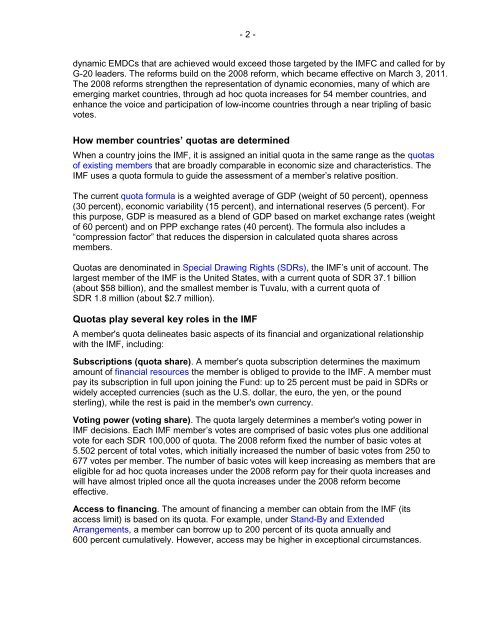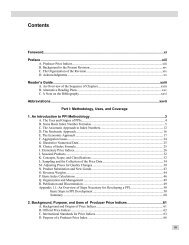You also want an ePaper? Increase the reach of your titles
YUMPU automatically turns print PDFs into web optimized ePapers that Google loves.
- 2 -dynamic EMDCs that are achieved would exceed those targeted by the <strong>IMF</strong>C and called for byG-20 leaders. The reforms build on the 2008 reform, which became effective on March 3, 2011.The 2008 reforms strengthen the representation of dynamic economies, many of which areemerging market countries, through ad hoc quota increases for 54 member countries, andenhance the voice and participation of low-income countries through a near tripling of basicvotes.How member countries’ <strong>quotas</strong> are determinedWhen a country joins the <strong>IMF</strong>, it is assigned an initial quota in the same range as the <strong>quotas</strong>of existing members that are broadly comparable in economic size and characteristics. The<strong>IMF</strong> uses a quota formula to guide the assessment of a member’s relative position.The current quota formula is a weighted average of GDP (weight of 50 percent), openness(30 percent), economic variability (15 percent), and international reserves (5 percent). Forthis purpose, GDP is measured as a blend of GDP based on market exchange rates (weightof 60 percent) and on PPP exchange rates (40 percent). The formula also includes a“compression factor” that reduces the dispersion in calculated quota shares acrossmembers.Quotas are denominated in Special Drawing Rights (SDRs), the <strong>IMF</strong>’s unit of account. Thelargest member of the <strong>IMF</strong> is the United States, with a current quota of SDR 37.1 billion(about $58 billion), and the smallest member is Tuvalu, with a current quota ofSDR 1.8 million (about $2.7 million).Quotas play several key roles in the <strong>IMF</strong>A member's quota delineates basic aspects of its financial and organizational relationshipwith the <strong>IMF</strong>, including:Subscriptions (quota share). A member's quota subscription determines the maximumamount of financial resources the member is obliged to provide to the <strong>IMF</strong>. A member mustpay its subscription in full upon joining the Fund: up to 25 percent must be paid in SDRs orwidely accepted currencies (such as the U.S. dollar, the euro, the yen, or the poundsterling), while the rest is paid in the member's own currency.Voting power (voting share). The quota largely determines a member's voting power in<strong>IMF</strong> decisions. Each <strong>IMF</strong> member’s votes are comprised of basic votes plus one additionalvote for each SDR 100,000 of quota. The 2008 reform fixed the number of basic votes at5.502 percent of total votes, which initially increased the number of basic votes from 250 to677 votes per member. The number of basic votes will keep increasing as members that areeligible for ad hoc quota increases under the 2008 reform pay for their quota increases andwill have almost tripled once all the quota increases under the 2008 reform becomeeffective.Access to financing. The amount of financing a member can obtain from the <strong>IMF</strong> (itsaccess limit) is based on its quota. For example, under Stand-By and ExtendedArrangements, a member can borrow up to 200 percent of its quota annually and600 percent cumulatively. However, access may be higher in exceptional circumstances.
















